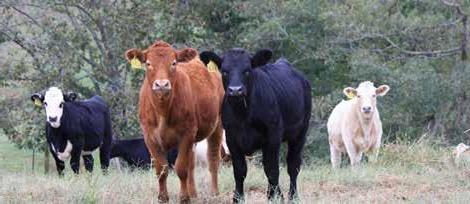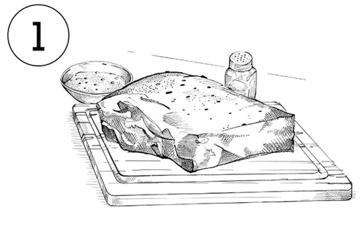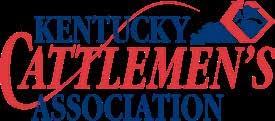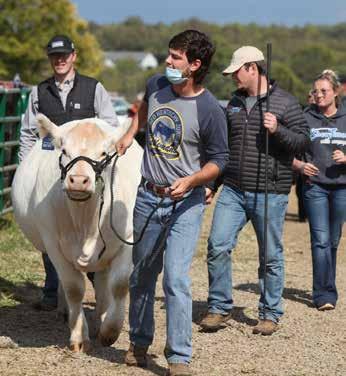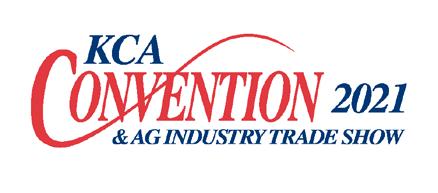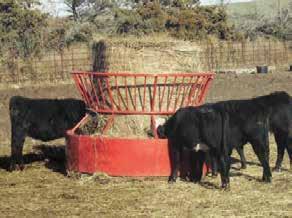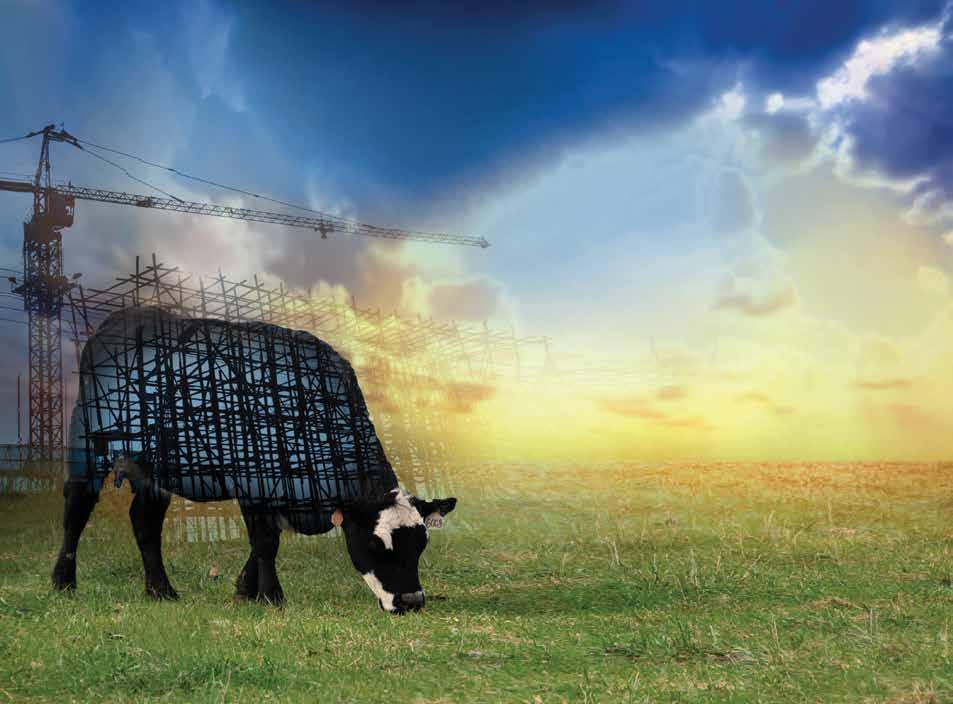
21 minute read
75 Things You Didn’t Know About Beef
Beef is a staple of American mealtime. Nutritious. Delicious. It is Americana on a plate. Producing beef requires the dedication of farmers and ranchers across the United States, and proper management of grazing animals can rebuild the health of pastures and rangelands. Since 1945, Noble Research Institute has supported farmers and ranchers in fostering land stewardship, improving the soil and producing one of the world’s favorite foods. In honor of Noble’s 75 years, below are 75 facts about beef.
Red, White and Beef
1. There are more than 800,000 ranchers and cattle producers in the U.S. 2. One-third of all U.S. farms and ranches include cattle. 3. Beef cattle are raised in all 50 states. 4. The top five states with the most beef cows are Texas, Oklahoma, Missouri, Nebraska and South Dakota. 5. As of Jan. 1, 2020, there were 94.4 million head of cattle in the U.S. herd. That’s more than the populations of California, Texas, Florida and Mississippi combined. 6. 91% of beef farms and ranches are family-owned or individually operated. 7. The average farm size in 2017 was 441 acres. 8. The average herd size in 2017 was 43.5. 9. Pasture and rangeland represent 41% of land usage in the U.S. 10. Cattle and calves made up nearly 40% of cash receipts for animals and animal products in 2018. 11. About 16 U.S. presidents can say they have experience with farming or ranching, including Theodore Roosevelt, who at one point owned 5,000 cattle in the Dakota Badlands and championed conservation efforts during his presidency. 12. The U.S. is the world’s largest beef producer, followed by Brazil.
A Global Presence
13. U.S. farmers and ranchers produce 18% of the world’s beef with only 8% of the world’s cattle. 14. Japan, South Korea and Mexico are the top importers of U.S. beef. 15. The U.S. ranked fourth in the world for amount of beef eaten per capita, at 79.3 pounds, in 2016. 16. Ahead of the U.S. in beef consumption per capita are Uruguay (124.2 pounds), Argentina (120.2 pounds) and Hong Kong (114.3 pounds). Beef on the Dinner Plate 17. Every day, 76 million Americans eat beef. 18. They consume, on average, 112 pounds of beef per year. 19. In 2018, U.S. consumers purchased 26.7 billion pounds of beef at foodservice and retail locations. 20. 70% of food service operators say that steak on the menu increases traffic. 21. The most popular beef products include ground beef, ribeye steak, strip steak and t-bone steak. 22. About 490 pounds of meat come from one 1,200-pound steer. 23. Beef is one of the most important dietary sources of iron. You’d have to eat three cups of raw spinach in order to get the same amount of iron in one 3-ounce serving of beef. 24. It’s also a source for other nutrients our bodies need, including protein, B vitamins, zinc, selenium, niacin, phosphorus, riboflavin and choline.
It’s Not All Steak
25. More than 98% of a beef animal is used. 26. 60% of a beef animal goes to make products other than meat. 27. One cowhide can make 18 soccer balls or 20 footballs. 28. Medical products, like insulin and drugs used to help the body accept organ transplants, are made from cattle. 29. Gummy bears and marshmallows often contain gelatin, which can be made from cattle.

30. Other products that may be made from cattle include candles, paintbrushes, deodorant, dish soap and toilet papers.
Cows Are Amazing Creatures
31. There are more than 800 different breeds of cattle in the world. 32. All “cows” are female. Before a female has a calf, she is called a heifer. She becomes a cow after giving birth. Males are called bulls or steers. 33. The gestation period for a cow, or the amount of time she is pregnant, is nine months — the same as a human. 34. Calves weigh approximately 80 pounds at birth. 35. A cow can smell odors from up to 6 miles away. 36. They only have a bottom set of teeth, which helps them eat grass. 37. And they have a rough, sandpaper-like tongue.
Ruminating Grazers
38. All cattle spend most of their lives eating grasses and other forages on grazing lands. 39. They can eat about 40 pounds of food a day. 40. Cows are ruminants, which means they have four stomach compartments. The largest is called the rumen. 41. The ruminant digestive system enables a cow to acquire nutrients from grasses, which humans cannot. Other ruminants include sheep, deer and buffalo. 42. As a ruminant, a cow digests plants by repeatedly regurgitating and chewing them up again. A cow “chews its cud” for about eight hours a day.
Beef Through History
43. Cows were first domesticated about 10,000 years ago. 44. The ancestor of domesticated cattle is thought to be the now-extinct auroch, a horned, wild ox that was black and stood 6 feet tall at the shoulder. 45. Spaniards brought the first cattle to the Americas in the late 15th and early 16th centuries. 46. Cattle were first brought to Jamestown, in what is now Virginia, from England in 1611, according to the writings of John Smith.
CONTINUED ON PAGE 14
RELIGIOUS REFLECTIONS
BAXTER BLACK, DVM
WWW.BAXTERBLACK.COM
I was sittin’ in the back row of a beautiful little church in a mountain town in the Rockies. I was there for the wedding of a daughter of good friends. As the service progressed, my attention was drawn to a banner that hung on the wall. It was handmade, cut from cloth and intended to be inspiring. It read, Mount Up With Winos. Many thoughts went through my mind as I tried to absorb the full meaning of this elaborate banner. I had come to realize over the years that many Protestant churches have become more liberal in their teachings. Acceptance of alternative lifestyles, less moral browbeating, less blatant emphasis on money, more convenient schedules and greater tolerance of lesser sins; i.e. fall football, alcohol, sex and non-Christian religions. And there is something to be said for that religious creed. After all, Jesus himself never discriminated. Bein’ a thinker myself, I began to concoct other potential banner slogans that might be acceptable in this New Age congregation; Ride with the Risque, Sail with Sinners, Lie Down with the Licentious, Commune with the Immoral, Huddle with the Homeless, Do Lunch with the Offender. The wedding audience was mostly ranch people, men with sunburned faces wearin’ new jeans and uncomfortable in their ties. The women wore their best dresses and the kids were glad to be anywhere off the ranch. We all squirmed quietly in our pews as the preacher read the vows, told them marriage was forever and lent dignity and tradition to what we all hoped would be a union made in Heaven. We were happy for the parents and appreciated the page turning in their life. We’d all been there or soon would be. I’d come with my family to pay tribute to the parents... my friends. But I admit my distraction with the banner had consumed a good part of my attention during the service. I began to think that it was inappropriate. When the soloist rose and sang the final George Strait love song while the bride and groom escaped, she was positioned right below the banner. Poor planning, I thought, or at least in poor taste. As we were filing out I asked my daughter what she thought of the banner. “Which one?” she asked. “The one right above the singer,” I answered. She studied it and read aloud, “Mount up with Wings. Kinda cool, I guess. Why?” “Oh,” I said, vowing silently to start wearing my glasses more often, “Just curious.”





REGISTERED ANGUS BULLS FOR SALE
Dennis Craig & Randy Sparks, Owners Sammy Ayres, Manager • 859-983-9488 2661 Clintonville Road • Winchester, KY 40391
CONTINUED FROM PAGE 11
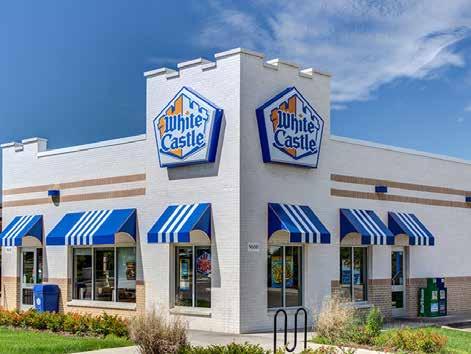

47. Colonists were raising enough cattle by the 1630s that they no longer needed to rely on imported cattle from Europe. 48. The hamburger was popularized at the 1904 World’s Fair in St. Louis. 49. You could buy a hamburger for just 5 cents in 1921 and 12 cents in 1950. 50. The first hamburger chain was White Castle, which was founded in Wichita, Kansas, in 1921. 51. Today’s beef producers use 33% fewer cattle to produce the same amount of beef that they did in the 1970s. The industry uses natural resources much more efficiently today.
Reducing Environmental Impact
52. U.S. beef represents only 2% of U.S. greenhouse gas emissions, but work continues to be done to improve. 53. According to a study comparing beef production in 1977 to 2007, each pound of beef is produced with 20% less feedstuffs and 9% less fossil fuel energy. 54. The carbon footprint of a unit of beef produced decreased by 16% from 1977 to 2007. 55. Water use decreased by 14% from 1977 to 2007. 56. The U.S. beef industry continued to reduce water by 3% from 2005 to 2011. Growing on Grazing Lands 57. There are 655 million acres of pasture and rangeland in the U.S., making it the single largest land use in the country. 58. About 85% of U.S. grazing lands are unsuitable for producing crops. 59. Rangelands naturally evolved with the presence of fire and grazing, making them processes that the land continues to need today. 60. One acre of rangeland or pasture may have about 1,000 pounds of standing plant mass and as much as 3,500 pounds of roots below ground, in the top foot of soil. 61. It takes 2,000 years for natural processes to make 10 centimeters of fertile soil. That’s why it’s so important to protect the soil from erosion and other degradation. 62. Ranchers are building up — not just conserving — the soil on pastures and rangelands by following five basic soil health principles: 1. Cover the Soil. 2. Minimize Soil Disturbance. 3. Practice Plant Diversity. 4. Maintain Continuous Living
Plants/Roots. 5. Integrate Livestock.
Building Organic Matter
63. The earthy smell of a biologically healthy and active soil is the presence of an organic compound called geosmin. 64. Up to 1 billion bacteria can reside in a single teaspoon of productive soil. 65. Healthy soil with high levels of organic matter can store 20 times its weight in water, according to the Food and Agriculture Organization. 66. A 1% increase in soil organic matter can help the soil hold about 20,000 gallons of additional water per acre. 67. Increased water-holding capacity reduces the need to use water for irrigation and improves the land’s resiliency in drought.
Capturing Carbon
68. Researchers say more carbon resides in soil (2,500 billion tons) than in the atmosphere (800 billion tons) and all plant/animal life (560 billion tons) combined. 69. Grazing lands sequester about 30% of Earth’s carbon pool, according to a Global Change Biology publication. 70. Increasing soil organic matter in pastures and rangelands will help reduce atmospheric carbon dioxide. By creating carbon sinks — natural reservoirs that can hold carbon — we can reduce the greenhouse effect and slow atmospheric warming. 71. A study in California found that grasslands and rangelands were more resilient carbon sinks than forests. Grazing lands store carbon underground in roots and the soil, whereas trees store it in their leaves and woody biomass — which release carbon back into the atmosphere during wildfires.
A Home for Wildlife
72. Cattle and wildlife can be compatible with proper management on native rangelands. 73. The most important considerations when managing the two together are habitat and cattle stocking rate. 74. One California-based study published in Conservation Biology found that cattle grazing plays an important role in maintaining wetland habitat necessary for some endangered species. 75. More than half of farmers intentionally provide habitat for wildlife.
#EATBEEF
NATHAN LAWSON
Director of Kentucky Beef Council
CENTRAL KENTUCKY ANGUS ASSOCIATION 58th ANNUAL FALL SALE SATURDAY, NOV. 14 1:00pm (EST)
Central Kentucky Angus Sales Pavilion Danville, Kentucky
Our lives are filled with tags these days. Like brands, tags tend to associate us with our interest, our work, what we support, sometimes what we don’t and even our priorities. There are all kinds of tags; name tags, truck tags, ear tags, back tags, dog tags, hunting tags, even hashtags, all of which we use to identify ourselves or our property. Cattle are a great example. Think about how we use an ear tag in our cow herd. We might include age, sire, dam, sex, birthdate, and at the least, a number, on that little three by four-inch space. That ear tag is so important! It identifies the animal, helps pass information with the animal and most importantly helps us in the management and care of the animal. My kids have learned the first question out of my mouth when they’ve been checking cattle and notice something out of the ordinary will be, “what’s her tag number”? They are starting to catch on! Similarly, a trip down the road in your community is surely filled with passing waves as you meet friends and neighbors, many of whom you identify at a good distance by the tag on the front of their vehicle. That license plate is nearly a badge of honor for us. From our favorite farm equipment to family names to what we grow, we tend to reserve that license plate space for what we’re proud to associate with. Growing up my Uncle managed a cow/calf operation in Spencer county. His three sons and I were real pals growing up, more like brothers than cousins. We spent a lot of time bouncing around the cab of a 1979 Ford F150 4x4, riding along as my Uncle checked cattle. Blue in color, one of the things that made that truck (my Uncle) so identifiable was the ‘EAT BEEF’ license plate mounted to the front bumper. You knew who that truck belonged to by that tag! The old Ford has been retired from service, the Eat BEEF tag it carried is mounted in the shop and both have been replaced by newer versions, but their functions remain the same. Like little moving billboards traveling our streets and roads the Kentucky Beef Council, EAT BEEF tags are a hot item! Annually, KBC will distribute roughly 4000 of these tags! Interestingly tags have taken on a new meaning today. Social media has created an opportunity for interested individuals to follow certain hashtags according to their interest. In fact, the hashtag #EATBEEF has over 54,000 followers on Facebook and Instagram. Much like a tag on a vehicle, this hashtag identifies posts connecting followers to beef producers and social media stories that highlight what life is like for beef producers. Opportunities like this allow people who have a growing interest in where their food comes from, a pathway to learn more through social media. While these opportunities are great for advertising purpose, tags and hashtags also present us with a challenge. The challenge is to provide our consumers with a factual, but positive experience with the stories behind their food. Ultimately our brand will leave a lasting impression. Positive experiences will yield positive results. Let’s make sure we’re identifying our industry in a positive way and putting our best foot forward as we identify ourselves with Beef! Happy Thanksgiving to you and yours!

SELLING: 110+ HEAD

REGISTERED BULLS & COMMERCIAL FEMALES
REGISTERED: 15 BULLS • 11 FALL YEARLINGS, 4 COMING TWO YEARS OR OLDER • ALL ARE DNA TESTED WITH CURRENT BSEs
100 COMMERCIAL FEMALES:
48 BRED HEIFERS TO CALVE IN THE SPRING. MAJORITY OF THESE ARE PUREBRED ANGUS BRED TO CALVING EASE ANGUS BULLS WITH ABOUT HALF BRED TO AI SIRES 24 BRED COWS. 10 TO CALVE THIS FALL, BALANCE IN THE SPRING 8 COW/CALF PAIRS 9 OPEN HEIFERS. READY TO BREED IN THE SPRING
4 miles NE of Danville just off of Highway 34 on Chenault Bridge road and then Fork Church Road. GPS address: 2286 Fork Church Road, Lancaster, KY 40444 Sale to be held in the open sided sale barn (to improve social distancing).
SALE DAY PHONE: (859) 238.3195 or (859) 583.0364
DIEVERT SALES SERVICE • TIM DIEVERT 478 DRY FORK ROAD • DANVILLE, KY 40422 office: 859/236-4591• mobile: 859/238-3195 tdievert@dievertsales.com • Like us on facebook. For more details, contact the sale manager.
AUCTIONEER
Eddie Burks 270/991-6398
218th CKAA Sponsored Sale and the first one to offer only commercial females! Central Kentucky Angus Association Calendar of Events: November 14, 2020: 58th Annual Fall Sale • January 23, 2021: 57th Annual Winter Sale • April 17, 2021: 56th Annual Spring Sale • Contact Tim now if you have entries for the Winter Sale!
GETTING THE MOST OUT OF STOCKPILED GRASS
CHRIS D. TEUTSCH
UK Grain and Forage Center of Excellence, Princeton, Kentucky
Stockpiled tall fescue is the most economical way to feed cows during the winter months. Once stockpiled growth has accumulated, how you choose to utilize it can dramatically impact how many grazing days you get per acre. Research in Missouri showed that giving cows access to only enough forage for 3-days versus 14-days resulted in a 40% increase in grazing days per acre. The following tips will help to get the most out of your stockpile. Graze pastures that contain warmseason grasses first. Although we often like to think of pastures as monocultures, they are often complex mixtures of cool- and warm-season grasses, legumes and weedy forbs. If pastures contain warm-season grasses, use these first since their quality will decline rapidly in late fall and early winter. Graze pastures containing clover next. We are always happy to see clover in pastures. However, in a stockpiling scenario it does not hold up to freezing and thawing as well as tall fescue. So mixed pastures before pure stands of tall fescue. Save pastures with primarily tall fescue for later grazing. Tall fescue is by the best grass for stockpiling in terms of maintaining its nutritive value as you head into winter. So graze pure stands last. Strip graze tall fescue. As mentioned above, limiting access to stockpiled forage can significantly increase grazing days per acre. Strip grazing usually starts at the water source and then uses a single strand of electrified polywire to allocate only enough forage for the predetermined time period. It could 1, 2, 3, or more days. The shorter the time period the better utilization you will get. Since pastures are not actively growing during the winter months, you can start at your water source and no back fencing is needed. Expert Tip: When strip grazing, never take your forward fence
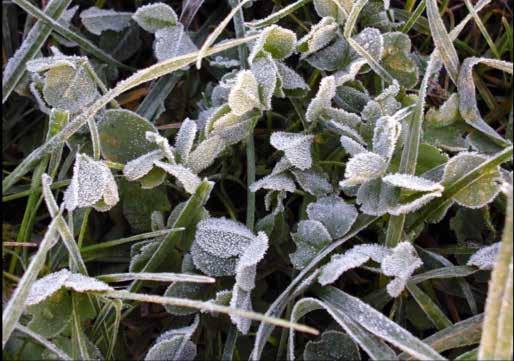
Figure 1. Grass-clover mixtures should always be grazed first. down until the back fence (new one) is up. If you do, the cows will be on the other side of the pasture! To many producers that have not strip grazed, the idea of moving a temporary fence two or three times a week or even once a week can seem overwhelming. However, once you are set up it really goes pretty fast and the pay backs are huge—a free day of feed every time you move the fence. Is it less work than feeding hay? Probably not less, but just different and the pay back is much better. The last thing that I want to mention about utilizing strip grazing is how often you move the fence needs to fit your schedule. Many producers work off the farm and it is dark when they leave and dark when they get home. So for them it makes sense to move the fence once a week on Saturdays or Sundays. It is important to remember that grazing systems need to benefit not only the pasture and cows, but also you!

Figure 2. Strip grazing stockpiled grass is accomplished by starting at the water source and allocating only enough pasture for 2 to 3 days of grazing using temporary electric fencing.

Figure 3. It is ok to make your cows work! In this photo strip grazing stockpiled tall fescue drastically improved utilization.
FORAGE MANAGEMENT TIPS
• Apply 30 to 40 lb N/A to strengthen cool-season pastures. • Using a grazing stick or plate meter, estimate standing forage that is available for winter grazing. • Inventory hay supplies. • Adjust animal numbers or purchase additional hay to balance feed supply to livestock numbers. • Test hay and develop supplementation strategies to maintain body condition of cows. • If available, graze crop residues and cover crops that will not overwinter. • Begin grazing winter annuals once they are 6-8 inches tall and root systems are well anchored. • Utilize temporary electric fencing and solar chargers to more efficiently graze winter annuals and stockpiled forage. • Alkaloid content of tall fescue pastures can be high, but will begin to decline after a hard freeze.
Tim Dievert 478 Dry Fork Rd. • Danville, KY 40422 Office:859/236-4591 (C)859/238-3195 • tdievert@dievertsales.com www.dievertsales.com
Catalogs or more information available by contacting Tim Dievert.
BRD? IT UP HOOK
Handy and convenient — and with the same active ingredient as the name brand.
Norbrook Norfenicol® is a first-choice, broad-spectrum antibiotic for control and treatment of BRD. Packaged with a unique hanger bottle, just hook it up on the chute and move cattle through to deliver benefits over Nuflor®, like: • Less viscous and more syringeable • Unbreakable plastic bottles • Shorter Sub-Q withdrawal prior to slaughter
Contact your veterinarian or visit NORBROOK.COM
Central Kentucky Angus Association’s 58th Annual Fall Sale: November 14, 2020 • Danville, KY New for 2020: Selling registered Angus bulls & commercial females
Call Tim for consignment information orfenicol® (florfenicol)
Observe label direction and withdrawal times. Federal law restricts this drug to use by or on the order of a licensed veterinarian. For use in beef and non-lactating dairy cattle only. Not approved for use in female dairy cattle 20 months of age or older, including dry dairy cows. Animals intended for human consumption must not be slaughtered within 28 days of the last intramuscular treatment or within 33 days of subcutaneous treatment. Do not use in calves to be processed for veal. Intramuscular injection may result in local tissue reaction which may result in trim loss at slaughter. See product labeling for full product information, including adverse reactions. The Norbrook logos are registered trademarks of Norbrook Laboratories Limited. Norfenicol is a registered trademark of Norbrook Laboratories Limited. Nuflor is a registered trademark of Merck Animal Health. 1020-591-I01B
PUB: Cow Country News SIZE: 4.667”x9.5” COW COUNTRY • NOVEMBER 2020 • A PUBLICATION OF THE KENTUCKY CATTLEMEN’S ASSOCIATION BLEED: NO 1/2 page vertical
For intramuscular and subcutaneous use in beef and non-lactating dairy cattle only. BRIEF SUMMARY (For full Prescribing Information, see package insert.)
INDICATIONS: Norfenicol is indicated for treatment of bovine respiratory disease (BRD) associated with Mannheimia haemolytica, Pasteurella multocida, and Histophilus somni, and for the treatment of foot rot. Also, it is indicated for control of respiratory disease in cattle at high risk of developing BRD associated with M.haemolytica, P. multocida, and H. somni. CONTRAINDICATIONS: Do not use in animals that have shown hypersensitivity to florfenicol.
NOT FOR HUMAN USE. KEEP OUT OF REACH OF CHILDREN.
Can be irritating to skin and eyes. Avoid direct contact with skin, eyes, and clothing. In case of accidental eye exposure, flush with water for 15 minutes. In case of accidental skin exposure, wash with soap and water. Remove contaminated clothing. Consult physician if irritation persists. Accidental injection of this product may cause local irritation. Consult physician immediately. The risk information provided here is not comprehensive. To learn more, talk about Norfenicol with your veterinarian. For customer service, adverse effects reporting, or to obtain a copy of the MSDS or FDA-approved package insert, call 1-866-591-5777. PRECAUTIONS: Not for use in animals intended for breeding. Effects on bovine reproductive performance, pregnancy, and lactation have not been determined. Intramuscular injection may result in local tissue reaction which persists beyond 28 days. This may result in trim loss at slaughter. Tissue reaction at injection sites other than the neck is likely to be more severe.
RESIDUE WARNINGS: Animals intended for human consumption must not be slaughtered within 28 days of the last intramuscular treatment. Animals intended for human consumption must not be slaughtered within 33 days of subcutaneous treatment.
Not approved for use in female dairy cattle 20 months of age or older, including dry dairy cows as such use may cause drug residues in milk and/or in calves born to these cows. A withdrawal period has not been established in pre-ruminating calves.
Do not use in calves to be processed for veal. ADVERSE REACTIONS: Inappetence, decreased water consumption, or diarrhea may occur transiently. Manufactured by: Norbrook Laboratories Limited, Newry, BT35 6PU, Co. Down, Northern Ireland. The Norbrook logos and Norfenicol ® are registered trademarks of Norbrook Laboratories Limited.


